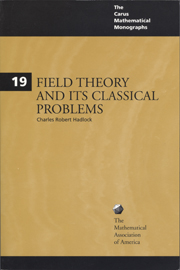CHAPTER 2 - FIELD EXTENSIONS
Summary
Arithmetic of Polynomials
In the last chapter, we saw how certain classical geometric construction problems depended for their solution on the nature of the roots of certain polynomials. We shall take another look at these problems later in this chapter. In the next chapter, we shall look at another famous problem, namely, the problem of trying to find analogues of the quadratic formula for the roots of polynomials of degree greater than 2. Since all these investigations deal with polynomials, we need first to learn more about the ‘arithmetic’ of polynomials.
Given a field F, we denote by F[x] the set of all polynomials over F in the variable x. As we shall see, this set has many properties very similar to those of the set Z of integers. First, F[x] is closed under the operations of addition, subtraction, and multiplication. But, like Z, it is not closed under division; the quotient of two polynomials is not necessarily a polynomial. In place of division, we have ‘division with remainder’. For example, in Z, we cannot simply divide 7 by 3; but we can say “7 divided by 3 is 2 with remainder 1”; and we can write this, entirely within Z, as: 7 = 3 • 2 + 1; 2 is called the quotient and 1 is called the remainder.
- Type
- Chapter
- Information
- Field Theory and its Classical Problems , pp. 59 - 122Publisher: Mathematical Association of AmericaPrint publication year: 1975

